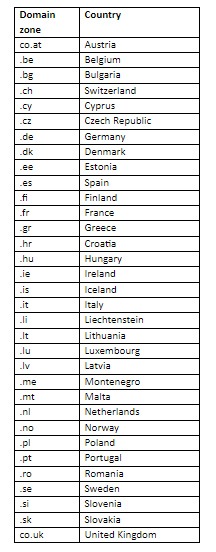
Top 5 Mistakes eCommerce Companies Make When Entering the European Market
Europe is big with a population of 743M people and offers huge growth potential for U.S. eCommerce companies.
EU eCommerce is almost as big as U.S. eCommerce with 703B USD vs 891B USD (2019) but it’s a really tough task to enter the whole of Europe in one move as the continent is separated by countries, languages, and cultures. That’s why we do marketing activities on a country level rather than targeting Europe as a whole. This allows us to maximize performance and reach better ROI per 1 euro invested.
Since 2013 we have invested more than 175,000 hours managing digital campaigns for our clients in Europe, we have seen not only wins but also failures which gives us an incredible amount of valuable experience we can share with you.
When planning to do business in Europe, it’s really important to be prepared, to know the markets, to know your competitors, and the specifics of each market in each targeted European country. If you don’t follow certain steps, your short and long-term performance is severely impacted. To help you to be more successful, we have created a list of some of the most common mistakes eCommerce companies make when entering the European market. Avoid them if you wish to increase your success rate and grow your business.
Mistake 1: One Domain for All EU Countries
The customer journey is sophisticated and before making a purchase users will usually compare products, proposals, and companies. If you have a .com domain and your competitors have local domains this is a clear signal to potential customers that you’re not local. This is one of the reasons people don’t buy as they think there may be potential problems with payments, delivery, returns, customer support etc. People don’t like to take risks when buying online, especially if there’s a local company selling the same item at a similar price and if the customer has had a bad experience buying from abroad previously.
According to MasterCard research, three out of every four shoppers (74%) in Europe are more likely to shop with local companies. Thus, when entering Europe you should follow the rule “Think globally, act locally”. Consider buying domains in the local domain zones you’ll be targeting, for example .de for Germany, .pl for Poland, .fr for France. Consumers say that local businesses provide*:
- More personalized service: 96%
- Trust – treating the customer fairly: 91%
- Better customer service: 80%
- Quality workmanship: 86%
- Reliability – delivering what’s promised: 79%
- Professional staff: 75%
The following list of domain zones in Europe will help you pinpoint the domain/s you should purchase.

Mistake 2: Website Only Being in English
According to Google research, 56% of Europeans are not willing to use websites that are not written in their native language whilst Harvard Business Review says 72% of consumers spend most of their time on websites in their own language.
Mistake #2 is closely connected with mistake #1. An English only approach won’t be a winning strategy as users compare your website, products, and proposal with local competitors. A website written only in English will raise a lot of questions about delivery, payments, support, returns, etc. and people usually don’t wish to spend their time finding answers to their concerns, they simply buy from your local competitor whose website is written in the native language.
Yes, the most common language spoken in Europe is English and yes, cross-border sales in Europe (e.g., a customer from Germany buying a product from the UK) are becoming more popular each year but we’re talking about local competition inside each country. To get sustainable growth you have to ensure your eStore is written in the local language.
One of the reasons why your eStore might be ok written in English only is if you have a unique proposal. In this situation, you can keep your website in English but you should put a bit more effort into the preparation stage to take care of meeting trust factors (social proof, etc.).
Mistake 3: PayPal as the Only Payment Method
When you target country by country, you should consider offering different payment methods. PayPal is the most popular payment option in many European countries but if PayPal is the only option it will limit your growth and decrease ROI. A lot of people in Europe are using alternative payment options since most countries have local providers such as PayU in Poland, PayDirekt in Germany, Klarna in Norway, and Carte Bancaires in France.
You should define the most popular payment methods/providers and implement these options into your eStore checkout before you start any marketing activities. This will increase your eStore’s conversion rates. The easiest way to find out the best set of payment methods/options is to spy on local market leaders to see what they use.
Mistake 4: Not Providing Local Delivery Options
It’s ok if you offer delivery by DHL but if this is the only delivery option you have, you’re at risk of limiting your growth. As with the previous point, you should know the local market very well and be aware of the most popular delivery preferences. For example, in Germany, the most popular/preferred delivery companies are Deutsche Post, DHL, Hermes, and DPD. In the UK, if you’re not offering delivery with Royal Mail, DPD, or Hermes you’re at risk of losing clients and money. Meanwhile, if operating in France you should definitely consider offering shipping via Colissimo by La Poste, Chronospost, and/or DPD.
As we always say to our exporting eCommerce clients, when visiting a new website, users don’t look for arguments on “why to buy”. They’re looking for reasons “why not to buy”. A website without trust factors and no choice on the delivery method are perfect “why not to buy” signals. So be sure you provide at least one popular delivery method in the country you operate in.
Mistake 4: Website Is Translated Rather Than Localized
Even good translation agencies may not get it right. Many marketers remember Electrolux epic U.S. market entrance with the translated slogan “Nothing sucks like Electrolux”. Funny, but when it comes to your business and your ROI it’s not so funny anymore.
We have seen many examples of websites having translated text by “native speakers” working within translation agencies. The result is usually bad which significantly impacts your business in Europe. You should be sure that your website text and Ad copy is localized by a local linguist living in the country where you operate. The best way to do this is to give your text to a local linguist for proofreading. Here’s some of our local linguist feedback regarding website text translated from Czech to German (translated good agency in Czech):

Mistake 5: No Local Customer Support
According to Forbes, 84% of companies that work to improve their customer experience report an increase in their revenue. We totally agree with this statement.
After you start marketing and operational activities in a particular country, people will start to contact your support team. It’s rare for people to contact you saying “Thanks for a great product and fast delivery”, instead they want answers to important questions whether relating to a product pre-purchase, order delivery status, order details, technical issues, or to complain. If they don’t get fast answers from a native speaker there’s a high probability that your business metrics will be deemed poor and it will be very difficult to improve them. In some cases, you can solve this challenge with an FAQ section but this isn’t ideal as people don’t want to spend a lot of time reading and searching for an answer to their specific question.
If you’re new on the market, people will not trust you as much as they trust your local competitors as you have no history and no social proof in that particular country. Live local support in this case can significantly improve the situation and give you the opportunity to scale your business much faster.
We see, on average, a 27% increase in conversion rate after the client adds local support to their website. Also, check our brand new best e-commerce agencies in the UK directory if you’re looking for one.























